Birds can fly in our homes–safely!
There are many articles on the internet discussing the pros and cons of wing clipping. However, these assume that the “pros”–usually argued from a safety perspective–can only be attained if the bird’s flight is limited or eliminated by having its wings clipped. In this section of the site, we will explore the commonly mentioned dangers a flighted bird may encounter and learn how we can minimise or eliminate those dangers from the bird’s environment. I will first discuss dangers in the home, then concerns about parrots accidentally flying out the door. After reading this page and others on the site, consider whether there are truly more pros to wing clipping than there are cons. NOTE: Although I have tried to cover as much as possible, this is not an exhaustive list. When pursuing flight, it will be necessary to evaluate your own home for dangers and make the necessary adjustments.
Windows, glass doors, and mirrors worry many people when discussing flight for birds. Fortunately, this is one of the easiest concerns to address. Birds can learn to safely avoid windows, glass doors, and mirrors. The ideal time for them to do this is, of course, while they are learning to fly as babies. Because they are forming their understanding of the world as they experience it, baby birds need only to consistently identify the window or mirror as a solid object in order to avoid it in the future. The baby bird may bump into the window or mirror initially, while it is still a clumsy flier, but this is comparable to a toddler bumping into things as it learns to walk and move about the room. We can’t compare an adult bird who has never seen a window before, who rushes into it at top speed, to a baby bird testing its environment. If you and I had grown up without ever seeing windows, mirrors, or sliding glass doors, could we be expected not to crash and hurt ourselves if suddenly surrounded by them?
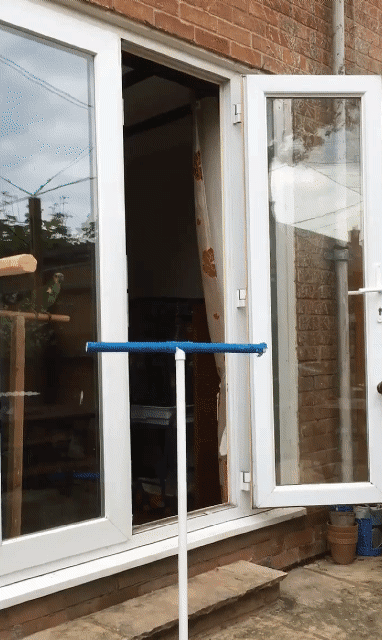
This amazon demonstrates that birds, given experience and acclimation, are just as capable of identifying and avoiding panes of glass as we are. Credit: Monika of Parrot Harness and Free Flight UK.
A bird who has passed the stage of learning to fly as a baby can still learn how to avoid these; it just requires a little more precaution while teaching them. Starting off in a smaller room with windows and mirrors covered allows the bird to familiarise itself with its surroundings without the added challenge of a solid-yet-transparent object. Windows and mirrors can be uncovered partially, then fully. As suggested by parrot behaviour consultant Pamela Clark, a bar of soap can be rubbed onto windows and the layer of soap gradually removed as the bird learns. Masking tape is another option. After the bird recognises that windows represent solid barriers and can fly around them reliably, the tape can be removed. For birds who are comfortable perching on a hand, they can also be introduced to windows and mirrors by watching a human tap on these objects. They can even tap them with their beaks and experience the solidness themselves. Suction-cup perches can be added to windows as well, if desired, offering the bird a place to land when it flies toward them.
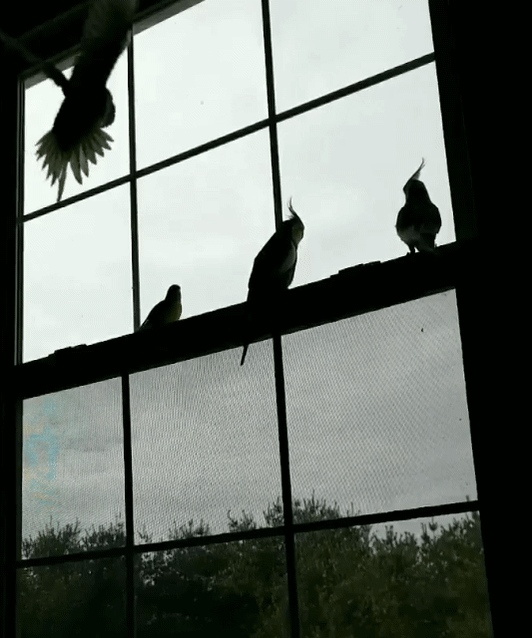
When birds are raised in an environment with windows (or gradually introduced to them as adults), they have no difficulty avoiding them. In fact, they tend to enjoy landing on them to take in the view. The pros and cons of wing clipping typically discussed involve pros for the human and cons for the bird. Safety can be achieved in far better ways than clipping.
Ceiling fans are dangerous to birds, for obvious reasons. Once we know how important flight is to a bird, we can’t really prioritise using a fan with exposed blades over a bird’s natural mobility. I completely understand that some people live in very hot climates, don’t have air conditioning, and so on and so forth. Fortunately, we can do a few different things. We can use pedestal fans or box fans when the bird is out and in rooms that it has access to. We can run the ceiling fan at night when the bird is in its cage. (Safety covers like this can be placed over switches that control fans as an extra reminder not to flip them.) We can purchase a bird-safe ceiling fan to install in an area where the bird will most likely spend a lot of time, such as the living room. (Bird-safe ceiling fans can be found by searching online for “enclosed ceiling fans”. You can check out one great example here.) Obviously these are more expensive than a cheap standard ceiling fan, but birds are, in general, not inexpensive pets. You’re going to be paying for a cage/aviary, food, perches, toys, and at some point, vet visits. If you really can’t live without a ceiling fan, 200-some dollars doesn’t seem like much to invest in exchange for your bird’s ability to move normally and exercise for the rest of its life. Ceiling fans with exposed blades are fairly common in most homes, but so is non-stick cookware, and we can’t use that around birds, either. Sometimes we just have to make adjustments for our pets. Personally, I have never felt ceiling fans to be particularly effective, an opinion I held well before I owned any birds. In the absence of air conditioning, I much prefer a fan placed in the window coupled with a pedestal fan near my person.
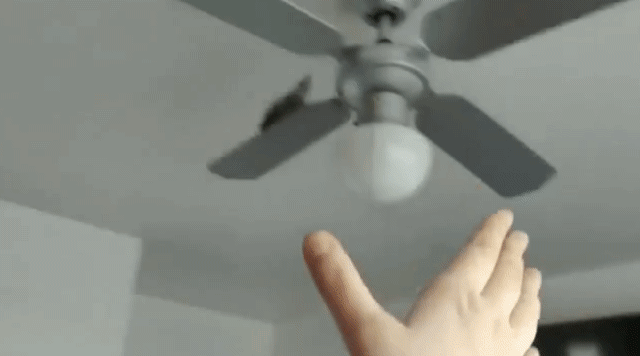
For this cockatiel, the ceiling fan is just another perch to practise recall from. There are much better fan options that can be run in the presence of birds. Credit: @peppered_cosmos on Instagram.
The kitchen stove seems to cause people a lot of grief when they think about flight, but the solution is incredibly simple: just put your bird in a room with the door closed or in a cage while cooking. Cooking is not exactly a bird-friendly activity, and it’s probably ideal if they’re nowhere near the kitchen while it’s happening. Birds have incredibly sensitive respiratory systems and, even if none of your cookware contains polytetrafluoroethylene (PTFE)–also known by the brand name Teflon–there are still gases and chemicals produced while cooking that are better off not entering their lungs. A person might be comfortable cooking with a clipped bird nearby or on their shoulder because they assume the bird can’t fly. The same bird may suddenly take flight if startled or lose its balance and end up in a heated pot or pan. Putting birds away or in another room while cooking is the safest option for multiple reasons.
As for toilet bowls, there is once again an incredibly simple solution: just keep toilet seats closed. Leave a note up for yourself and family members if necessary until it becomes a habit. In all honesty, if you flush with the toilet seat up, this causes bacteria to be sprayed into the air and all over the room. It is far more sanitary to flush with the toilet seat down, which means shutting it after each use. Keeping a flighted bird happens to encourage you to be more hygienic. Thanks, birds! Other open sources of water which a bird could drown in (pot soaking in the sink, big glass of water on the table, etc.) should not be left out uncovered unless the bird is being supervised.
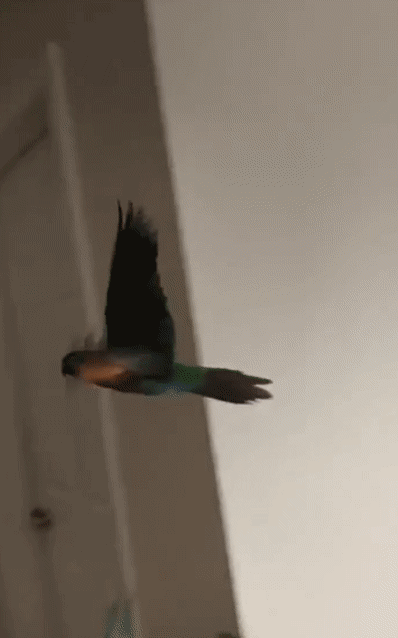
Birds are capable of incredible control and precision which make flight in the house a piece of cake. The key to unlocking this control and precision in our pet birds is to, ideally, allow for fledging and normal development. Should normal development not take place, it is up to us to facilitate gradual learning in a safe environment. Clipping feathers and changing the shape of a bird’s wing–a shape which is aerodynamically optimised–will not help them master flight any more than hobbling a dog will help it master an agility course. Credit: @bird_tails on Instagram and TikTok.
Cats and dogs are commonly cited as a household danger but, frankly, it is questionable as to whether one should mix either of these with birds. Regardless, if a flighted bird is not safe around cats/dogs, a clipped bird most certainly is not. I have heard the argument that a bird will be less likely to trigger predatory instincts if it can’t fly and that it can be put on a high perch where dogs can’t reach. Cats and dogs may be stimulated by seeing a fast-moving animal in flight, but that doesn’t mean they aren’t stimulated by seeing a small animal scurrying on the ground. If they only went after flying animals, they wouldn’t kill mice, squirrels, and rabbits, among others. Many common dog breeds have been specifically bred to assist with bird-hunting. Thus, there is just no truth to the idea that cats and dogs will leave a flightless bird alone but will viciously pursue a flighted one. Furthermore, a flighted bird at least has a chance to get out of harm’s way. Should a clipped bird find its way from a perch to the ground–whether by falling, fluttering, climbing, or jumping—in the presence of a cat or dog, it may find itself in grave danger.
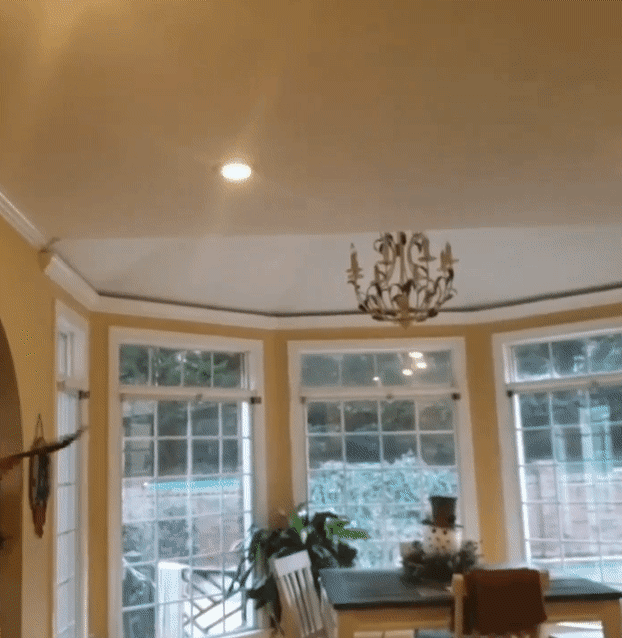
I have often seen the argument that larger birds cannot safely fly in the home. This, of course, is untrue. Large birds learn how to avoid obstacles just as well as small birds. It may be more challenging for them fly in certain spaces, but that does not mean they will crash into walls and windows. Credit: @peace_of_parrots on Instagram.
Like I said, this is not an exhaustive list of in-home dangers. There are other things to consider when keeping a flighted bird. For example, if your bird is free to fly around the room, you will need to ensure there are no toxic substances left out for them to ingest. You will need to supervise your bird or keep electrical cords out of their accessibility. (Cord protectors are an option for some species.) However, after enumerating all of these dangers, I would like to point out that clipped birds are not immune from harm in the home. Clipped birds can be stepped on, sat on, shut in closing doors, and, if something scares them, they may even launch themselves into the same dangers people mention when discussing flighted birds. Clipped birds do not have the same level of coordination as a skilled flyer, so they can’t very easily avoid a stove or container of water, even if they recognise the danger. They can injure themselves when crashing to the floor, and they can fly into walls or windows if startled. Flighted birds who are accustomed to flying in the home environment avoid these obstacles because they have the knowledge and experience to do so. Ultimately, there will be risks associated with keeping birds in captivity, flighted or clipped. It is better to equip our birds with training and provide them an environment compatible with their natural movement.
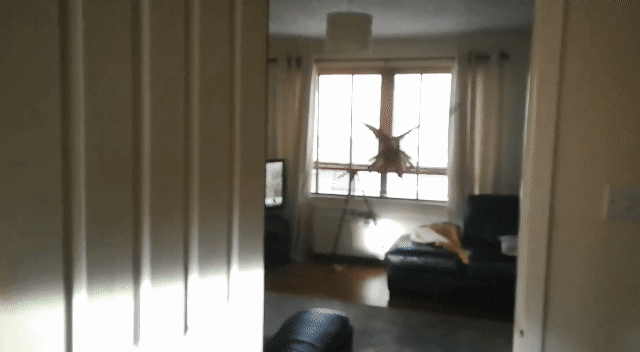
Even macaws with very large wingspans can manoeuvre safely within the home. If doorways prove too uncomfortably narrow, most large birds will adapt by walking through them and then flying within the rooms themselves. We must give birds the opportunity to develop flight skills instead of fearing their ability to fly. Credit: @flying_orion on Instagram.
Finally, we come to the question of escape. So many people say that they clip their bird so it “can’t fly away”. But clipped birds–even ones which have not flown for years–can and will attempt flight when badly frightened because it is an instinctual response. No one wants to watch their bird disappear out of sight or land in the street as they come to the crushing realisation that it was flightless only until its survival instincts kicked in. Unfortunately, this is exactly what so many have felt. People answer doors with their clipped birds on their arms or shoulders because “they can’t fly”. People take their clipped birds out in the yard, unrestrained, because “they drop like a rock”. People leave an unscreened window or door open just a bit too long because their birds “have been clipped their entire lives”. The false sense of security impressed upon bird owners through clipping is so much more dangerous than being fully dedicated to flight and taking every precaution necessary.
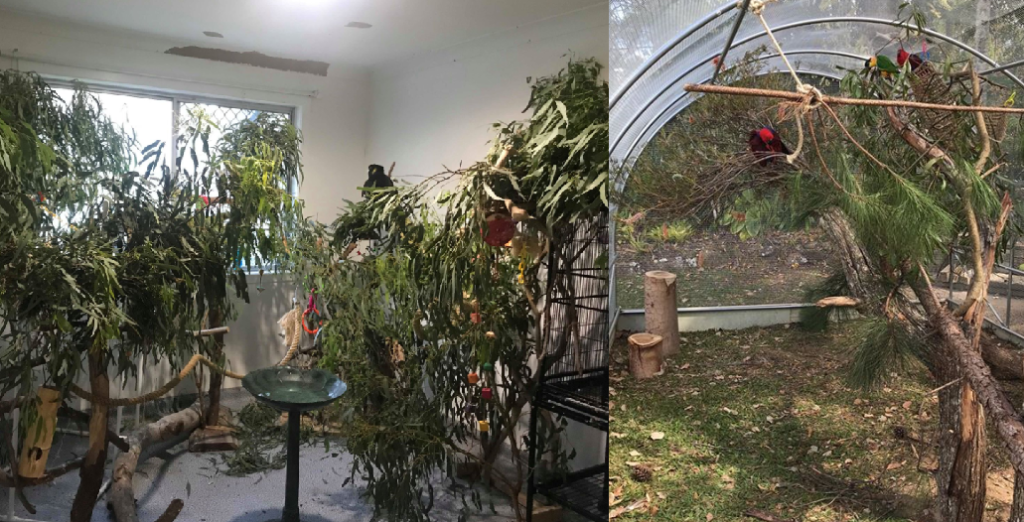
Bird rooms, indoor aviaries, and outdoor aviaries provide birds with secure, flight-friendly spaces. While not possible for every bird owner, they are certainly worth mentioning. Credit: @flightedfeathers on Instagram (bird room) and @chewwbird on Instagram (aviary).
A “magnetic screen door” (click the link and check them out–they’re extremely useful!) can be affixed to entry/exit doors as an added barrier. One can hang a sign on the front door while birds are out to notify family members; they can then knock or ring the doorbell so that birds can be put in their cages or in a different room before the door is opened. People with garage doors can preferentially enter/exit the home through the garage as this creates an excellent double-door fail-safe. People with more than one entry/exit to the home might use the one that makes it the hardest for a bird to reach quickly. One may also consider using a specified room for the birds to fly in during times when people may be busily entering and exiting the home. Living with flighted birds may sound difficult if one is unaccustomed to it, but it becomes a very natural part of life. I don’t know anyone with flighted birds who has difficulty with following safety precautions that suit their household and lifestyle.
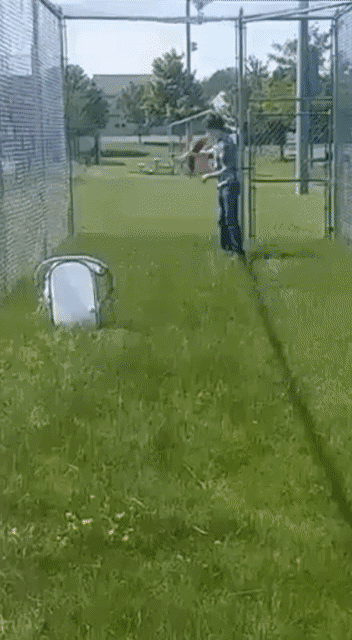
Clipped birds can indeed fly. This scarlet macaw was clipped before fledging and was unaware that flight was possible. With muscle-building exercises and positive reinforcement, she gained the confidence to take off on her own, fly to the end of the batting cage, and land on her new owner’s arm. The takeaway from this video is that her wings are clipped and she is not a particularly strong or skilled flyer, but she can fly. It is very difficult to obtain video of clipped birds spooking and flying off since it is typically unexpected by the owners and therefore not filmed. However, I hope this serves as an illustration of just how easily a clipped bird can fly out of sight or into serious danger.
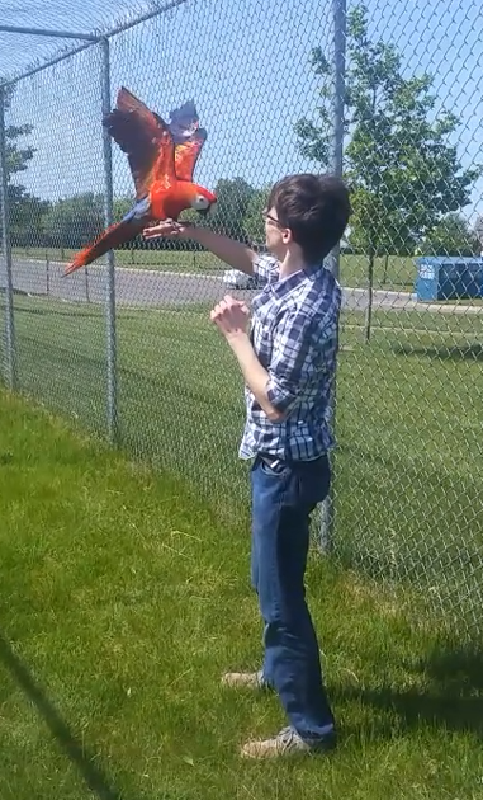
This still image should alleviate any doubts that her wings were clipped at the time of the video. Parrots are prey animals and instinctively respond to perceived threats by taking flight, regardless of whether they consciously know how to fly in other situations. While still in the care of her first owner and not receiving any fitness or flight training, she took to the air in the backyard and flew into the side of a house. Because most clipped birds can theoretically fly with the right training (or a sudden fright), it becomes clear that long-term clipping is actually more about ensuring muscle atrophy and an aversion to attempting flight than it is a mechanical restriction imposed by altering feathers.
Please, take a look at the 911 Parrot Alert Facebook group and search for the word “clipped”. You will see many accounts of clipped birds flying away. You will see statements like “wings are clipped but somehow managed to get out of the house” and “we always took him outside since his wings are clipped, but next thing we knew he was gone”. What kind of odds does a clipped bird have out there, being disabled? How can it avoid predators, seek shelter, find food/water, or make its way to a human if it is uncoordinated and tires easily? Fully flighted birds—particularly trained ones—are recovered all the time. It is rather tragic when people clip them after being recovered, and I find it very discouraging that people would respond in such a manner. The ability to fly properly is what kept those birds alive until the owner could recover them. They made it home…and are then issued what amounts to an extreme punishment, regardless of how benevolent the owner’s intentions.

These are screenshots of two searches I did for the word “clipped” on the 911 Parrot Alert Facebook group, a group for posting lost and found pet birds. (Names have been removed from the posts in this image but are otherwise unchanged.) Browsing this group reveals that clipped birds most certainly can and do fly away. It also reveals that the odds of recovering a fully flighted bird are much better than we may have traditionally been led to believe. These are just a few examples, so I encourage you to check it out for yourself. Credit: 911 Parrot Alert (Official) on Facebook.
Furthermore, depriving a bird of all flight capability (as I explain elsewhere on this site) is harmful to physical and mental health. It also poses an increased risk of traumatic injury should the bird attempt to fly. This type of clip is steadily being abandoned by veterinarians and aviculturists. Thus, people who clip are increasingly opting for a “partial clip”. But partial clipping, while more humane, is not really the happy medium so many think it is. Partially clipped birds can still fly to some degree, which is exactly what makes it more humane. This does mean, however, that they fly well enough to slip out a door. Even birds said to be clipped so that they can only “glide down” and not fly up or straight can achieve some upward or level flight when startled. As a point of clarification, birds who are clipped (particularly to this extent) cannot “glide”. The laboured fluttering of a clipped bird does not match the definition of the word “glide” in any way. It is, quite frankly, a misnomer that suggests a higher level of flight skill than most clipped birds possess.
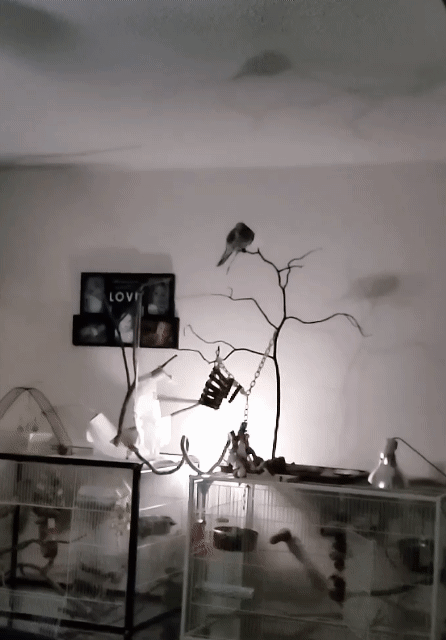
Many people erroneously refer to this type of descent from a perch as “gliding”. The definition of the word “glide” in the context of flight, according to the Cambridge Dictionary, is “to fly by floating on air currents instead of using power from wings or an engine”. The first definition, independent of flight, is “to move easily without stopping and without effort or noise”. Neither definition applies to the clumsy fluttering of a clipped bird trying to stay airborne while gradually falling.

This is a cockatiel gliding into a descent. Notice how the wings steer but do not flap as he cuts effortlessly through the air. To refer to what a clipped bird does as “gliding” is totally incorrect.
Clipped birds lack the coordination, fitness, and confidence of fully flighted birds, which may prove critical should they find themselves outdoors. Birds of prey are more likely to notice the clumsy, unnatural flight pattern of a clipped or partially clipped bird and deem it worthy of pursuit. Clipped birds are also less skilled with descending. This presents a serious barrier to recovery as most birds will land in a high place, such as a tree, for safety and can only return to humans by flying down. There is a dilemma brewing within the collective bird-owning consciousness: birds need to fly, but if they fly, we may lose them. The fact of the matter is that any pet on the planet can be lost due to carelessness or an accident. We do not need to physically handicap our birds or lightly clip their flight feathers to make ourselves feel better. We just need to learn how to take precautions and train them.

Many bird owners argue that clips similar to this one will reduce the chance of a bird injuring itself or escaping. This type of clip does not severely hinder a bird’s flight and is therefore substantially less harmful to its physical and mental health. However, there is no discernible way in which it makes the bird safer. NOTE: DO NOT TRY THIS AT HOME. THIS VIDEO IS FOR ILLUSTRATIVE PURPOSES ONLY. Credit: @feather_diaries on Instagram and TikTok.
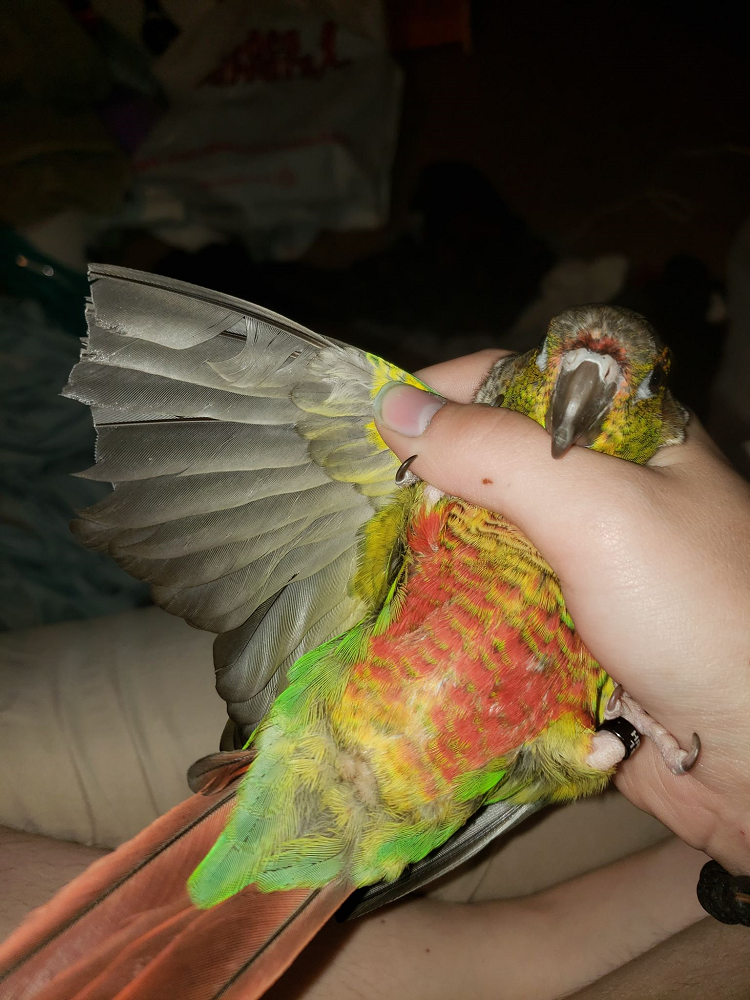
This conure has had six primaries on each wing conservatively clipped. The intention behind this partial clip was to make the bird “safer” while still allowing flight. This type of clip may seem like a winning compromise, but it serves as a disadvantage to the bird in situations where it would need optimal flight the most. Should a bird accidentally get outside, it needs to fly as well as possible in order to use its energy efficiently, avoid predators, find food/water/shelter, and descend to humans. Any kind of wing clip, even a partial one, negatively influences a bird’s ability to survive “in the wild”. Birds of prey also look for signs of weakness or abnormalities in their potential prey. Credit: @feather_diaries on Instagram and TikTok.
When it comes to the pros and cons of wing clipping, the cons outweigh the pros. Full flight, in combination with training and preventative household measures, is the healthiest and safest option. A fully flighted bird who has been familiarised with the area around the house and desensitised to outdoor sights and sounds stands a much better chance of remaining calm and staying nearby. If the bird is trained to come to the owner’s calls, recovering the bird becomes much more likely; birds trained in recall, who understand that flying to a human earns them food, will often go to humans for help when lost even if they cannot locate their owner. A bird is even better equipped to handle this situation if it has fledged normally and suffers from no developmental gaps due to not learning to fly at the correct age. This does not mean you should be any less careful with preventing a bird from getting out of the house–it simply means that you have increased your bird’s chances of being recovered instead of banking on their supposed inability to escape. (Birds who receive professionally prescribed preparation and training can actually learn to fly outdoors under specific and controlled circumstances. This is not appropriate for many pet birds and bird owners. It should not be attempted without a highly qualified and experienced mentor. For more information, please check out my section on free flight.)
Even after establishing a bird-safe environment, you may be wondering how to manage a flighted bird. How do you get it to come to you? In my next section, I discuss the true management alternative to clipping which simultaneously promotes a better relationship between human and bird: training!
Click here to learn about training a fully flighted bird!
Additional Resources
For more tips on keeping flighted birds safe in the home, please check out this excellent article by Pamela Clark: https://blogpamelaclarkonline.com/2019/05/22/part-six-ensuring-the-safety-of-your-flighted-parrot/
If your parrot does escape the home or get loose outdoors, here are some recovery strategies from Barbara Heidenreich: http://www.goodbirdinc.com/help-escape.html


